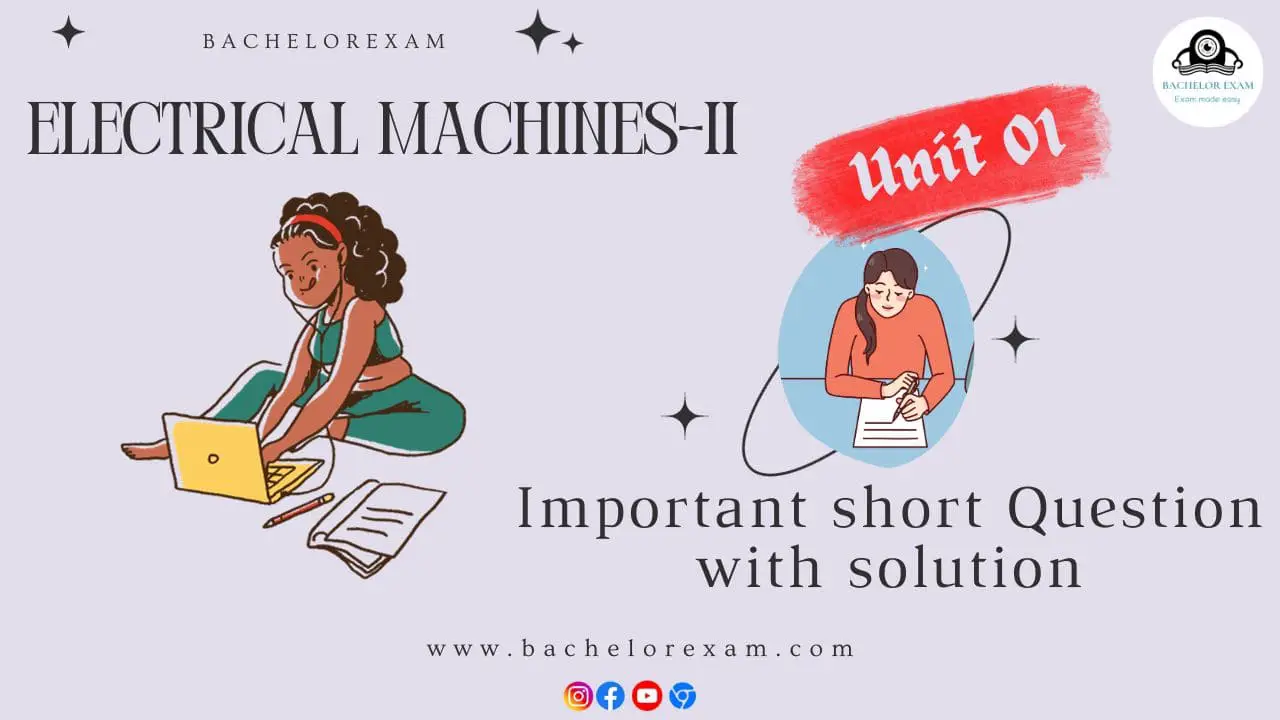Use Quantum Notes to increase your understanding of Electrical Machines-II. For success on your Aktu Btech examinations, access important frequently asked questions. Advance with us right now! Unit-1 Synchronous Machine-I
Dudes 🤔.. You want more useful details regarding this subject. Please keep in mind this as well. Important Questions For Electrical Machines-II: * Aktu Quantum * B.tech-Syllabus * Circulars * B.tech AKTU RESULT * Btech 3rd Year * Aktu Solved Question Paper
Q1. Discuss the construction of 3ɸ synchronous machines.
Ans. i. Stator:
- 1. The stator is a fixed armature. This is made up of a core and slots for the armature winding.
- 2. The stator core is made of laminated materials. It is made of specific steel stampings that are isolated from one another with varnish or paper.
- 3. The laminated architecture is primarily used to reduce eddy current losses. To reduce hysteresis losses, steel is typically used as the material of choice. The entire core is constructed in a steel plate frame.
- 4. The armature conductors are housed in slots on the core’s periphery. The frame carries no flux and serves as a support for the core.
- 5. Ventilation is maintained with the help of holes cast in the frame.



ii. Rotor:
There are two types of rotors used in alternators:
- a. Salient pole type:
- 1. This is also known as the projected pole type since all of the poles are projected out from the rotor’s surface.
- 2. The poles are constructed from thick steel laminations. As indicated in Fig., the poles are bolted to the rotor. The shape of the pole face has been determined. On the pole shoe, there is a field pole winding.
- 3 These rotors have large diameters and small axial lengths.
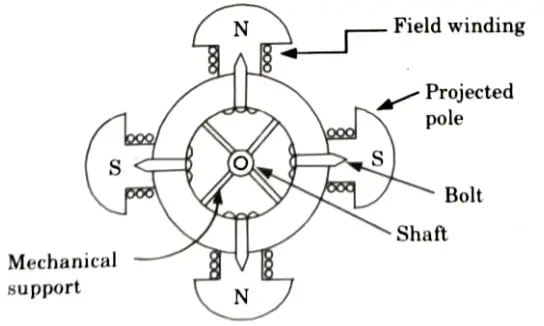


- b. Smooth cylindrical type:
- 1. This is also known as a non-salient or non-projected pole rotor. The rotor is made of a smooth solid steel cylinder with a number of slots for the field coil.
- 2. Steel manganese wedges are used to cover the slots at the top. The poles are the unslotted parts of the cylinder itself.
- 3. The poles are not protruding and the rotor surface is smooth, resulting in a constant air gap between the stator and the rotor.
- 4. Small diameters and long axial lengths characterize these rotors. This is done to keep peripheral speed within acceptable bounds.
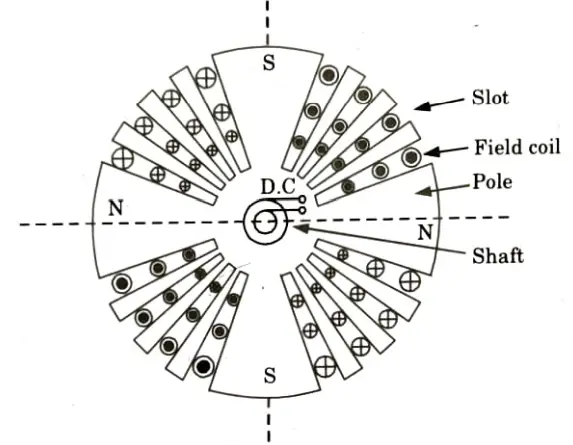


Q2. Why a rotating field system preferred against a stationary field in a synchronous machine ? A 2 pole alternator rotates at 3000 rpm. What is the frequency of the generated emf ?
Ans. A. Rotating field is preferred over stationary field due to following reasons:
- 1. A stationary armature is easier to insulate for the high voltage that the alternator is intended for. This generated voltage can reach 33 kV.
- 2. When the armature windings are in the stator, they can be mechanically braced better against strong electromagnetic forces caused by huge short-circuit currents.
- 3. Because the armature windings are immobile, they are not subject to vibration or centrifugal forces.
- 4. The output current can be drawn directly from fixed terminals on the stationary armature without the use of a slip ring, brushes, or other components.
- 5. The weight of the armature windings exceeds the weight of the field pole windings. As a result, the machine’s size is lowered.
- 6. Rotating field is comparatively light and can be constructed for high speed rotation.
- 7. The stationary armature may be cooled easily.
B. Numerical:
Given: Speed of machine, Ns = 3000 rpm, Number of poles, P = 2
To Find: Frequency of generated emf, f



Q3. What do you mean by “O.C.C.” and “S.C.C.” in synchronous machines ? Determine the values of synchronous reactance and short circuit ratio from O.C.C. and S.C.C.
Ans. A. Open-circuit test:
- 1. The alternator is run at rated synchronous speed and the load terminals kept open as shown in Fig. That is, all the loads are disconnected. The field current is set to zero.
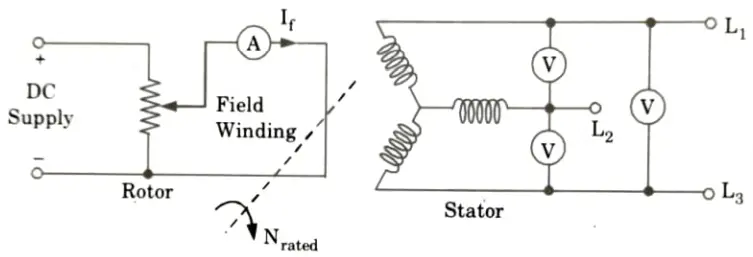


- 2. Then the field current is gradually increased in steps, and the terminal voltage Et is measured at each step.
- 3.The excitation current may be increased to get 25 % more than rated voltage of the alternator.
- 4. A graph is plotted between the open-circuit phase voltage



and field current If The characteristic curve so obtained is called open circuit characteristic (O.C.C.).



- 5. The extension of the linear portion of an O.C.C. is called the air-gap line of the characteristic. The O.C.C. and the air-gap line are shown in Fig.
B. Short-circuit test:
- 1. The armature terminals are shorted through three ammeters Fig.
- 2. The field current should first be decreased to zero before starting the alternator.
- 3. Each ammeter should have a range greater than the rated full-load value. The alternator is then run at synchronous speed.
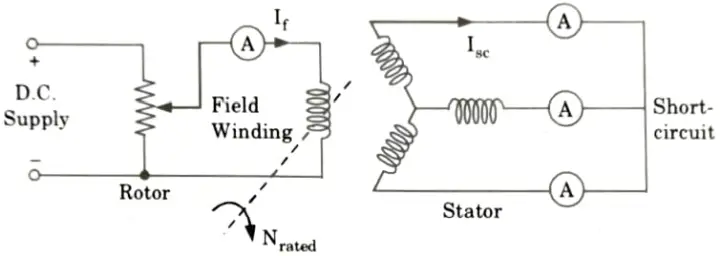


- 4. Then the field current is gradually increased in steps, and the armature current is measured at each step.
- 5. The field current may be increased to get armature currents upto 150 % of the rated value.
- 6. The field current If and the average of three ammeter readings at each step is taken.
- 7. A graph is plotted between the armature current Ia and the field current If The characteristic so obtained is called short-circuit characteristic (S.C.C.).
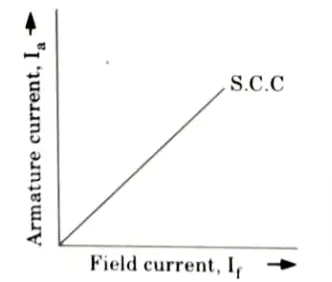


C. Calculation of Zs:
- 1. The synchronous impedance Zs is equal to the divided open-circuit voltage by the short-circuit current at that field current which gives the rated emf per phase.



- 2. Then synchronous reactance is,
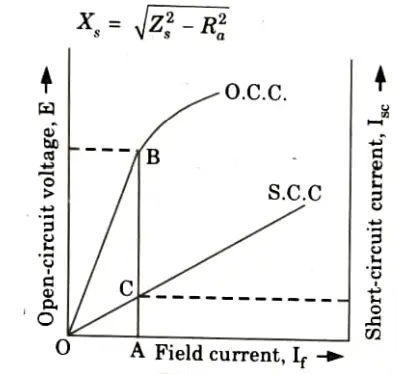


- 3. In Fig. consider the field current If = OA that produces rated alternator voltage per phase. Corresponding to this current the open- circuit voltage is AB.



D. Short circuit ratio (SCR):
- 1. The short circuit ratio (SCR) is the ratio of the excitation necessary to generate an open circuit voltage equal to the rated voltage to the excitation required to generate the rated full load current in short circuit.



Q4. Explain necessity and conditions of parallel operation of alternator.
Ans. A. Necessity :
- 1. Load growth: Load demand is rising as people use more electricity. The existing system may not be sufficient to meet the increased demand, so extra units of alternators must be added to match the increased demand.
- 2. Continuity of service: Instead of a single unit delivering electricity, the system should have several smaller units running so that if one fails, the other can meet the demand and continuity may be maintained.
- 3. Repairs: The units are occasionally removed from the system for repairs. In its place, another unit should be paralleled to the circuit so that the damaged unit can be removed for repair.
- 4. Maintenance: According to the maintenance plan, the units should be switched off and removed electrically so that the other unit can continue to deliver power and one unit can be paralleled to the system.
- 5. Efficiency: With virtually full load capacity, the machine operates at peak efficiency. If the system demand falls, that unit may run at a lower load condition and at a lower frequency. This is not cost-effective. As a result, the larger unit will be turned off, and a smaller unit will be introduced, allowing the smaller unit to operate at full capacity and with greater efficiency.
B. Conditions for satisfactory parallel operation of alternators:
- 1. A stationary alternator must not be connected to live bus-bars as its E = 0 and hence short circuit may occur.
- 2. The incoming alternator’s terminal voltage must be the same as the bus-bar voltage (rms values).
- 3. The entering alternator’s produced frequency must be the same as the bus-bar frequency.
- 4. The phase sequence of the incoming alternator must match that of the bus bar.
- 5. The incoming alternator terminals must have the same polarity as the bus-bar terminals. The magnitude of the alternator’s voltage can be controlled using a field regulator, and the frequency can be altered using speed variation.
Q5. A 1500 kVA, 3-phase star-connected 6.6 kV, 8-pole, 50 Hz synchronous generator has a reactance of 0.6 pu and negligible resistance. Calculate the synchronizing power per mechanical degree at full load and 0.8 power factor lagging.
Ans. Given: VL = 6.6 kV ,f = 50 Hz, P = 1500 kVA, P = 8
To Find: Synchronizing power, Psyn
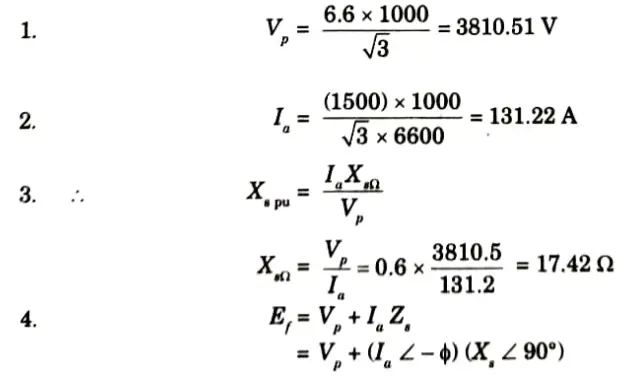





5. Synchronizing power per mechanical degree
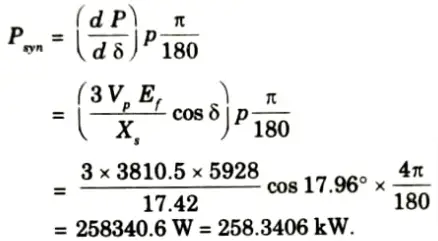


Q6. Discuss synchronous power and synchronous torque co-efficient for synchronous machine.
Ans.
- 1. Consider a synchronous generator transferring a steady power P0 at a steady load angle 𝞭0.
- 2. Suppose that, due to a transient disturbance, the rotor of the generator accelerates, so that the load angle increases by an angle d𝞭.
- 3. The operating point of the machine shifts to a new constant-power line and the load on the machine increases to P0 + 𝞭P.
- 4. Since the steady power input remains unchanged, this additional load decreases the speed of the machine and brings it back to synchronism.
- 5. Similarly, if due to a transient disturbance, the rotor of the machine retards, so that the load angle decreases.
- 6. The operating point of the machine shifts to a new constant power line and the load on the machine decreases to P0 + 𝞭P.
- 7. Because the steady power input stays constant, the reduced load accelerates the rotor. As a result, the machine regains synchronism.
- 8. The success of this corrective action is determined by the change in power transfer for each change in load angle. The synchronization power coefficient is a measure of effectiveness.
- 9. It is defined as the rate at which the synchronous power P varies with the load angle 𝞭. It is also called stiffness of coupling, rigidity factor, or stability factor and is denoted by Psyn.



- 10. Power output per phase of the cylindrical rotor generator



- 11. The synchronizing torque coefficient



- 12. For a cylindrical rotor machine, neglecting saturating and stator resistance eq. (1.27.2) and (1.27.3) become



- 13. For a salient-pole machine






Important Question with solutions | AKTU Quantums | Syllabus | Short Questions
Electrical Machines-II Btech Quantum PDF, Syllabus, Important Questions
| Label | Link |
|---|---|
| Subject Syllabus | Syllabus |
| Short Questions | Short-question |
| Question paper – 2021-22 | 2021-22 |
Electrical Machines-II Quantum PDF | AKTU Quantum PDF:
| Quantum Series | Links |
| Quantum -2022-23 | 2022-23 |
AKTU Important Links | Btech Syllabus
| Link Name | Links |
|---|---|
| Btech AKTU Circulars | Links |
| Btech AKTU Syllabus | Links |
| Btech AKTU Student Dashboard | Student Dashboard |
| AKTU RESULT (One VIew) | Student Result |
